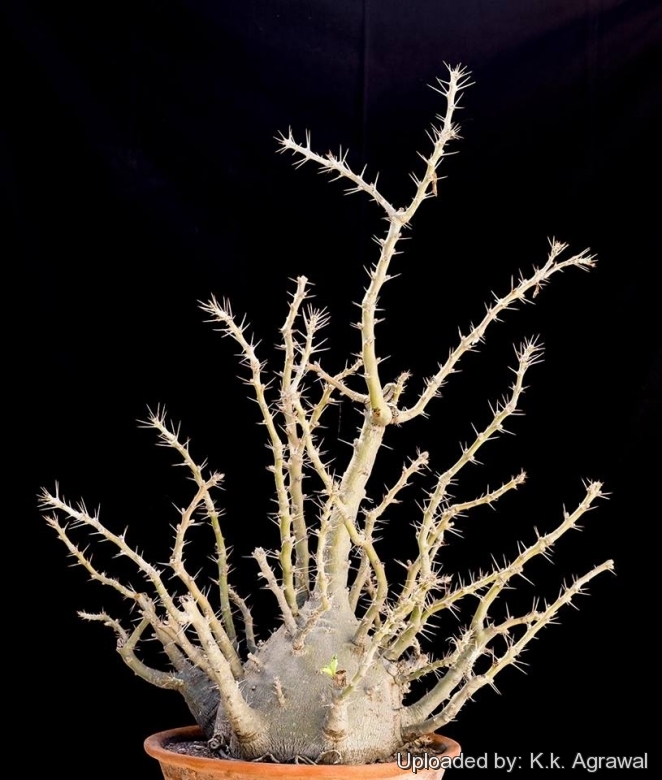
Pachypodium lealii subs. saundersii Photo by: K.k. Agrawal
Origin and Habitat: Pachypodium lealii subs. saundersiiSN|12215]]SN|12215]] is found in Mozambique, Zimbabwe, and Southern Africa (KwaZulu-Natal, Mpumalanga and Swaziland).
Natural habitat and ecology: It is a lowveld woodland inhabitant, usually occurring in open woodland in very stony places in full sun, often in rock crevices on exposed rock sheets on the ancient granite hills around Nelspruit on the Lebombo Mountains and other areas.
Synonyms:
See all synonyms of Pachypodium lealii
back
Accepted name in llifle Database:Pachypodium lealii subs. saundersii (N.E.Br.) G.D.RowleyNatl. Cact. Succ. J. 28(1): 4 (1973)Synonymy: 2
Accepted name in llifle Database:Pachypodium lealii Welw.Trans. Linn. Soc. London 27(1): 45. 1869 [24 Dec 1869]Synonymy: 2
back
Common Names include:
ENGLISH: Kudu Lily, Rathbonia
AFRIKAANS (Afrikaans): Koedoelelie
CHINESE (中文): 白馬城
LITHUANIAN (Lietuvių): Tankiašakis tukvis
RUSSIAN (Русский): Паxиподиум Сондерса, Звезда Лунди
SWEDISH (Svenska): Silverökenstjärna
ZULU (isiZulu): Insema-yamatshe, Isihlehle
Description: Pachypodium lealii subs. saundersiiSN|12216]]SN|12215]] (best known as Pachypodium saundersiiSN|12215]]SN|12216]]) is a fat pot-bellied stem-succulent. It is one of commoner Pachypodiums in cultivation. It produces terminal clusters of large white flowers tinged with purple, they are long-tubed and adapted to pollination by moths.
Stem: Shrubby, 1-2 metres hight and wide (wild), up to approx 1 x 1 m (garden), with a ball-shaped bole (tuber), up to 1 m in diameter, often irregularly shaped, rising little above the ground, little-branched. Branches erect, simple or sparingly re-branched above, densely spinous, thick at the base and tapering rapidly to 5-10 mm in diameter, glabrous, with a thin, papery greyish bark, deeply longitudinally wrinkled on drying. Short shoots (branchlets), with crowded slender spines up to 1 cm long, present in axils of main stem leaves.
Leaves: Subsessile (Petiole 0–3 mm long), spirally arranged on young branches or tufted near ends of axillary branchlets (abbreviated axillary shoots), oblanceolate, obovate to obovate-elliptic, apex obtuse and mucronate or acute, constricted towards the base, with spinulous margins, 25–80 mm long, 10–25 mm broad, thin-textured, drying blackish, often ephemeral. Hairless except for fine down on the midrib. The latter raised, other nerves usually obscure. Leaf sometimes strongly undulate.
Stipular spines: Spines on long shoots in spreading pairs, up to 2-3.7 cm long, stout, glabrous, straight, angled slightly upwards, with confluent swollen bases arising from a small cushion; a third, much smaller, spine also usually present proximal to the petiole. Spines on the short axillary shoots shorter.
Inflorescences (cymes): Terminal, sessile or subsessile , several-flowered, very condensed. Pedicels hardly any or up to 2-4 mm long. Axes glabrous. Bracts small, lanceolate, early deciduous.
Flowers: Large showy, white, tinged with pink to purple on outside of corolla, greenish within. Calyx 3-4 mm long, glabrous. Sepals ovate, acutely acuminate. Corolla white, tinged with pink. Tube 30-42 mm long, narrow in the lowest third below the stamens (for 10-12 mm), widened above them, then attenuate towards the mouth, externally glabrous, hairy within. Corolla lobes obliquely obovoid to almost triangular, asymmetrical, 1/2-2/3 as long as tube, much narrowed at the base, almost 2.5 cm long and wide, both surfaces glabrous. Stamens 5; anthers sessile, inserted at base of swollen part of corolla tube, 9-11 mm long, united in a cone, subsessile. Disc cupular, deeply 5-lobed. Ovary of 2 free carpels. Style 1, slender filiform, glabrous, attached to the two carpels at their apices. Style 2-lobed, stigma cylindrical with a basal rim.
Blooming season: It flowers in autumn at the end of the summer growing season. It generally bloom at a younger age than other Pachypodiums, typically around 4-5 years old.
Fruits: The fruit is a twin horn-like cylindrical follicle (two separate mericarps), spreading at a right angle when mature, spindle-shaped, attenuate at the apex, compressed, glabrous, pale to dark-brown with longitudinal lines or lenticellate outside, 8-10(-15) cm long, 1 cm in diameter, dehiscent.
Seeds: Numerous 6-7(-9) mm long, ovate in outline, compressed, with a apical coma (tuft of whitish or pale golden silky hairs) at one end, up to 2-2.5 cm long.
Subspecies, varieties, forms and cultivars of plants belonging to the Pachypodium lealii group
 Pachypodium lealii Welw.: Shrubby irregularly branched up to 1 m in diameter at the base erect or tree-like tapering or bottle-shaped with silvery bark. The branches are succulent about 1 (or more) cm in diameter
Pachypodium lealii Welw.: Shrubby irregularly branched up to 1 m in diameter at the base erect or tree-like tapering or bottle-shaped with silvery bark. The branches are succulent about 1 (or more) cm in diameter Pachypodium lealii subs. saundersii (N.E.Br.) G.D.Rowley: Shrubby to sprawling with a broad, bulbous base from which multiple trunks sprout. It produces terminal clusters of large white flowers tinged with purple.
Pachypodium lealii subs. saundersii (N.E.Br.) G.D.Rowley: Shrubby to sprawling with a broad, bulbous base from which multiple trunks sprout. It produces terminal clusters of large white flowers tinged with purple.
Bibliography: Major references and further lectures
1) S. H. J. V. Rapanarivo “Pachypodium (Apocynaceae)” CRC Press, 01/Jun/1999
2) Werner Rauh “The Wonderful World of Succulents: Cultivation and Description of Selected Succulent Plants Other Than Cacti” Smithsonian Institution Press, 1984
3) G. D. Rowley: Pachipodium. In: Urs Eggli: "Illustrated Handbook of Succulent Plants: Dicotyledons." Springer Verlag, 2002
4)Rowley, G. “Pachypodium & Adenium.” in: Cactus File 5: 1-79. 1999
5) Rapanarivo, S. H. J. V. & A. J. M. Leeuwenberg. “Taxonomic revision of Pachypodium. Series of revisions of Apocynaceae XLVIII.” in: Rapanarivo, S. H. J. V. et al., "Pachypodium (Apocynaceae): taxonomy, habitats and cultivation." 1999.
6) Eggli U., Newton L.E. & Rowley G.D., "CITES Aloe and Pachypodium Checklist" Board of Trustees of the Royal Botanic Gardens, Kew, 2001
7) Otto Stapf. “Flora Capensis”, Vol 4, page 490, 1909
8) A. J. M. Leeuwenberg and F. K. Kupicha et al. “Flora Zambesiaca”Vol 7, Part 2, 1985
9) Dr J.P. Roux “Flora of South Africa”, 2003.
10) Wikipedia contributors. "Pachypodium saundersii." Wikipedia, The Free Encyclopedia. Wikipedia, The Free Encyclopedia, 12 Aug. 2015. Web. 13 Sep. 2015.
 Pachypodium lealii subs. saundersii Photo by: Xero Sicyos
Pachypodium lealii subs. saundersii Photo by: Xero Sicyos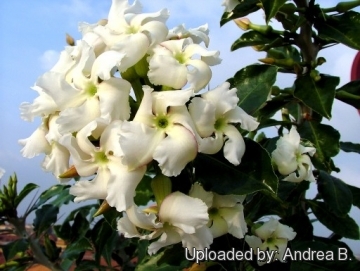 Pachypodium lealii subs. saundersii Photo by: Andrea B.
Pachypodium lealii subs. saundersii Photo by: Andrea B.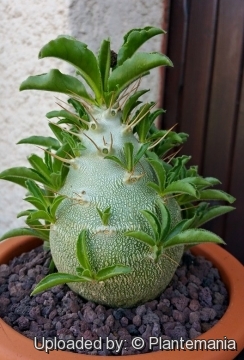 Pachypodium lealii subs. saundersii Photo by: © Plantemania
Pachypodium lealii subs. saundersii Photo by: © Plantemania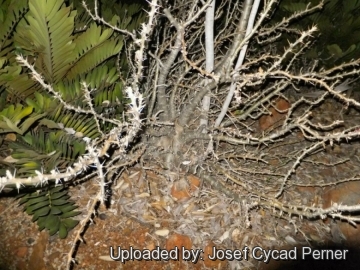 60 cm caudex diameter at Cycad International, Katherine, Northern Territory, Australia. Zamia furfuracea on the Left. Photo by: Josef Cycad Perner
60 cm caudex diameter at Cycad International, Katherine, Northern Territory, Australia. Zamia furfuracea on the Left. Photo by: Josef Cycad Perner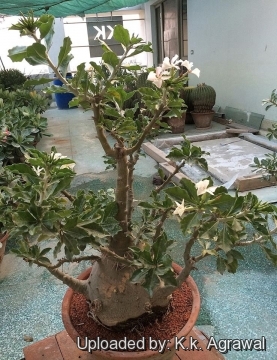 Pachypodium lealii subs. saundersii Photo by: K.k. Agrawal
Pachypodium lealii subs. saundersii Photo by: K.k. Agrawal Pachypodium lealii subs. saundersii Photo by: Xero Sicyos
Pachypodium lealii subs. saundersii Photo by: Xero Sicyos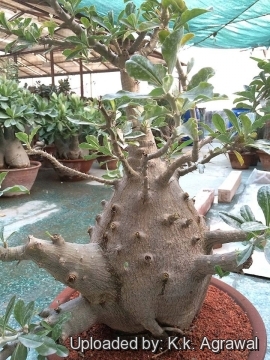 Pachypodium lealii subs. saundersii Photo by: K.k. Agrawal
Pachypodium lealii subs. saundersii Photo by: K.k. Agrawal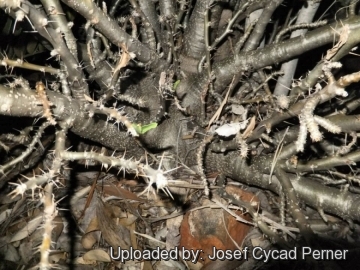 60 cm caudex diameter at Cycad International, Katherine, Northern Territory, Australia. Photo by: Josef Cycad Perner
60 cm caudex diameter at Cycad International, Katherine, Northern Territory, Australia. Photo by: Josef Cycad PernerCultivation and Propagation: It is probably the easiest and fastest South African Pachypodium to grow. This species is dormant in winter, keep it totally dry when leafless. They seem to need a cooler winter dormancy to bloom properly.
Your Photos

by © Plantemania

by Giuseppe Distefano





















